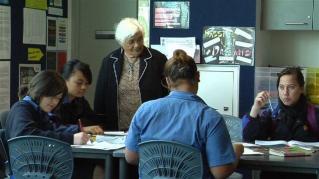Section navigation

This clip, about changes at Taihape Area School, focuses on the importance of engaging Māori students, in order to keep them at school. This aligns with Ka Hikitia, the Ministry’s Māori education strategy, which highlights the correlation between Māori students’ presence at school, their engagement in the learning process, and their resultant achievement.
Questions / Things to think about / Activities
- In terms of Ka Hikitia, with its focus on Māori students’ presence, engagement and achievement, what data do we collect on Māori student attendance? How do we judge Māori student engagement? What does our data-gathering tell us about the achievement of Māori students in our class/school?
- Ka Hikitia highlights the issue of Māori students becoming disengaged with secondary school – especially in years 9 and 10. How can our school address this area of vulnerability – so that those students not only attend school but are meaningfully engaged and achieve success? How can we specifically support years 9-10 Māori students and their whānau to make decisions about their future education? How do we include Māori students in decision-making that affects the quality of their education?
- What evidence is there that shows what works for Māori students, in terms of monitoring attendance? (See for example p 34 in Key evidence: Ka Hikitia). How can we use this evidence?
- How can we strengthen our planning and reporting mechanisms so that there is an explicit focus on Māori student engagement and achievement?
- ERO's report on Māori achievement (2006) highlighted that the weakest area of school performance was monitoring the effect of different programmes/interventions targeted at improving Māori achievement. How can we address this situation in our school? In what ways does our school try to ‘fit’ the Māori student – rather than the Māori students having to ‘fit’ the system?
- In 2006, ERO reported a correlation between Māori student engagement and attendance. How could we collect, and act on, data about absenteeism?
Filed under: Productive partnerships | Effective leaders





